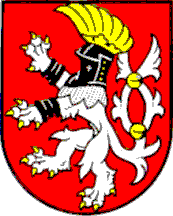
The city, the 9th-most populous in the country, is situated in a mountainous district at the confluence of the Bílina and the Elbe (Labe) Rivers, an active river port and important railway junction. A trading centrer as early as 993, the city was founded by King Otakar II of in the latter part of the 13th century. War ravaged over the centuries, during the 19th century the city became heavily industrialized. Mining, chemical manufacture, and river transport were important then and still today. Ústí was a center of early German socialism. Bombing by the Allied Forces from April 17 to April 19, 1945 killed 500 people. On July 31, 1945, the Ústí Massacre against German civilians occurred. In 1945 and 1946, over 53,000 ethnic Germans were expelled from the area. Emigrants from the Soviet Union, Slovakia, and Romania settled in the city. After the fall of communism in the Velvet Revolution of 1989, the city's heavy industry suffered economic trauma. Střekov castle is located in a southern suburb of the city. The Jewish community in Ústí nad Labem dates from 1848. From the 1860s until 1938, Usti nad Labem's population of about 100,000 had a thriving Jewish community, who contributed greatly to the town's industrial, economic, and cultural development. Men like Eduard Jakob Weinmann and Ignaz Petschka played an important role in Europe's coal industry and even had its own coal exchange in the second half of the nineteenth century. On New Year's Eve 1938, the Nazis burnt down the local synagogue, which was converted into a meat factory. Part of Jewish population emigrated before WWII and part of the remain population left this area after annexation of Sudetenland. Most of the town's Jewish residents were sent to the Nazi death camps. Religious intolerance continued even after the war prompting many of the members of this community to emigrate afterwards. Religious freedoms came after 1989. In the 1950s, the Jewish part of the local cemetery was destroyed, Contemporary Jewish community efforts mean that members regularly for worship, especially during Jewish festivals. Life in the community is declining due to the absence of a young generation. 17 of the 50 members of the community in 2000 lived in Ústí nad Labem. Only 38 members were recorded by July 2005 most of whom moved to the city from Western Ukraine in 1945-1946. Holocaust Memorial dedicated to the 1,000 Jewish residents who perished in the Holocaust, a massive granite Star of David half immersed into the site of a former Jewish cemetery. also see article. See Fedorovič, T., Kaiser, V. History if Jewish community in Ústí nad Labem. 2005, 123 s. English translation: Jaroslav Izavčuk. ISBN 80-86646-12-2. Wikipedia [February 2009]
Jewish Community Ústí nad Labem Moskevská 26, 400 00 Ústí nad Labem, Tel.: +420/475 208 082 E-mail: This email address is being protected from spambots. You need JavaScript enabled to view it.
USTI NAD LABEM: US Commission No. CZCE000197
Alternate names: Ústí nad Labem [Cz], Aussig [Ger], Uście nad Łabą [Pol], Aussig an der Elbe, Ústina Labe, Ústí, Auszig. Town is located in Bohemia, Usti nad Labem at 50º40 14º02, 70 km NNW of Prague. Cemetery: 1600 meters W in Okruzni Street. Present town population is over 100,000 with 10-100 Jews.
- Town: Mayor Engineer L. Masin, Mestsky Urad, 400 01 Usti nad Labem; tel. 219.
- Local: Mestsky Urad-oddeleni kultury, 400 01 Usti nad Labem; tel. 219 11. Okresni Urad-Referat Kultury, 400 01 Usti nad Labem; tel. 216 and Okresni Muzeum, Lidicke namesti 1, 400 04 Usti nad Labem; tel. 251-09 and 243-88.
- Interested: Statni Zidovske Muzeum, Jachymova 3, 110 01 Praha 1; tel. 02/231-06-34 and 231-07-85.
Earliest known Jewish community was 1863. 1930 Jewish population was 985. Unlandmarked cemetery originated in 1892 (new part in 1924) with last known Conservative, Progressive/Reform Jewish burial in 1945. The cemetery suburban hillside, part of a municipal cemetery, has no sign or marker. Reached by crossing private factory school and gardens, access is open with permission with no wall, fence, or gate. The pre- and post-WWII size of cemetery is about 8000 sq. m.
No stones or no known mass graves exist. Within the limits of the site is a factory/school. The municipality owns the property used for agricultural purposes, recreation, and industrial-commercial use. Adjacent properties are commercial or industrial. Vandalism occurred during World War II probably, and frequently 1945-91 (liquidated 1980-85) with no maintenance.
Jan Marek, Na hranici 208, 405 05 Decin and Jiri Fiedler, z"l, Brdickova 1916, 155 00 Praha 5; tel. 02/55-33-40 on completed survey on 18 May 1992. Documentation: Hugo Gold: Die Juden und die Judengemeinden...Bohemens (1934); short histories of Usti nad Labem, notes of Usti nad Labem archives; and notes of Statni Zidovske Muzeum Praha. The site was not visited. Cemetery Director in Usti nad Labem; tel. 315-66, Ms. Svobodova; neighbors of cemetery: Mr. Kriz and Mr. Maixner at Kekulova Street 62 cemetery were interviewed in 1992.
